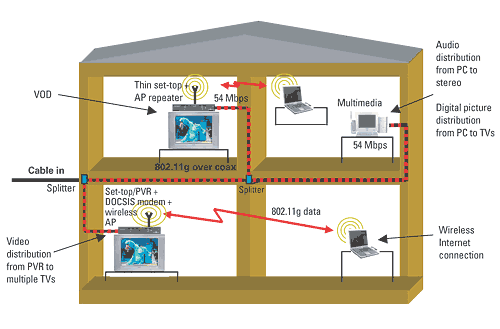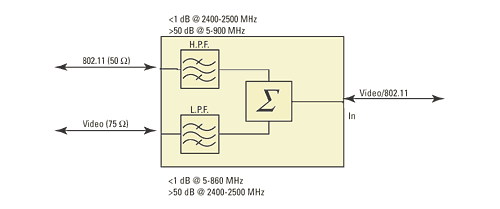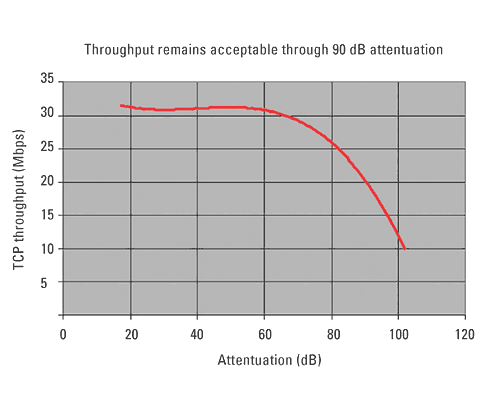Wireless Meets Coax:
Wireless home networking based on the IEEE 802.11 standard has gained market momentum over the past few years as higher bandwidth versions of the standard have been adopted at home and in corporate networks. The 802.11 advantages, which include no new wires, high data throughput, economies of scale and ubiquity at work, home and in public areas, are compelling. For data applications such as PC-to-PC connectivity, 802.11 wireless local area networks (WLANs) have proven to be the preferred solutions. Their performance for bandwidth-intensive applications such as video distribution, however, is questionable and may fall short of users’ expectations in terms of their video experience. This mainly is due to the coverage challenges inherent to 802.11 WLAN. The harsh and dynamic nature of the wireless channel-time-varying multipath and signal-fading-means that even in a typical home, the data throughput of 802.11g-a maximum of 54 Mbps-can drop to 1 Mbps or less when moving further away from the access point (AP). Because of this, 802.11 WLANs would benefit from an assist supplied by another more robust medium. The existing in-home coaxial cable is an ideal candidate for this. Instead of strictly using a wireless home network, we propose a home network that is based on 802.11 transmissions both over the air and over coax. Using the in-home coax to extend the range of the wireless network will allow cable operators to offer reliable video distribution with predictable capacity coverage throughout the home. Operators can take advantage of the capabilities and attributes of the 802.11 standards, including quality of service (QoS), security and low cost. The requirements for a successful multimedia home network include no new wires, throughput exceeding 20 Mbps, QoS, whole-home coverage, robust operation, simple installation, coexistence with other home appliances and low cost. The hybrid 802.11-over-coax network uses 802.11g transmissions in the 2.4 GHz band as the protocol for both coax and over the air and meets all these requirements. Hybrid wireless/coax home net 
Figure 1: Hybrid Network in a Typical Home An example of a hybrid network is shown in Figure 1. The network includes three primary elements: The residential gateway on the ground floor is a digital set-top box with an embedded Data Over Cable Service Interface Specification (DOCSIS) cable modem. It also includes an 802.11g AP for data and video distribution. This AP supports both 802.11 over the air and 802.11 over coax. 802.11-over-coax gateway products already are reaching the market. A thin set-top box on the second floor communicates with the main set-top via 802.11 over coax. It hosts the repeater and is connected directly to the coax. The desktop computer on the second floor uses 802.11 over coax for its connection, but the laptop computers on the first and second floors are free to roam around the house. Any handheld consumer appliance with 802.11 connectivity also is free to roam. Every packet can be transmitted over the air, over the coax or both. All transmissions, be they coax or wireless, use the 2.4 GHz frequency band specified in 802.11b/g. In most homes, propagation loss in the coax connection is much lower than the over-the-air connection. That is because the air link must contend with walls and other structures. The 802.11-over-coax distribution is very robust and consistently provides the highest possible 802.11g data rate, which is 54 Mbps. The QoS capabilities of 802.11e will ensure efficient use of the hybrid network, guarantee the allocation of bandwidth and limit the latency for services requiring QoS. Homes with cable access to broadband will implement CableHome functions in the set-tops to manage the network. It should be noted, however, that the hybrid wireless-coax network will work with any other access technology such as digital subscriber line (DSL) or satellite. 802.11-over-coax topology Three basic devices in various combinations comprise any 802.11-over-coax network: server/access point devices, client station devices (STA) and wireless extender (WEX) devices, which are a hybrid of the first two. Each device also consists of a passive matching splitter that connects to the coax network. Just as the name implies, server/access point devices provide two functions-they serve as access devices to both the wide area network (WAN) and as servers to manage the hybrid coax-wireless network. Typical host products could be a set-top box, a personal video recorder (PVR) or a DVD player. These products include an internal 802.11 AP module connected by an internal bus. The AP can transmit the signal via the antenna or coax by adjusting a switch (as done today when selecting between two antennas). No system changes are needed for a standard 802.11 AP. Client station devices may be a computer, thin client set-top or any other roaming device. Some can connect to the AP wirelessly, while others may use a fixed coax connection to communicate via 802.11 over coax. The wireless extender is a hybrid device that serves as a client over the coax network and extends the reach of the wireless network. Matching splitter 
Figure 2: Matching Splitter The only additional hardware needed for an AP or STA device to operate in the hybrid network is a matching splitter. The splitter is used to connect the device to the coax network and is a bi-directional passive device that consists of a low-pass filter for video and a high-pass filter for 802.11 devices. A diagram is shown in Figure 2. The matching splitter plays four roles: it matches impedance between the 50 ohm 802.11 antenna and the 75 ohm coax network, filters RF noise, protects the home appliances and cable plant from 802.11 transmission interference and ensures zero transmission interference from other home appliances to the 802.11 network. The splitter may be internal or external. Technical implementation Components in existing in-home coax networks were designed for signals below 900 MHz. However, thanks to the exceptional robustness of the 802.11 signal, it still can operate at its native 2.4 GHz band. The next area of concern is analyzing the attenuation and reflections of the signal over the in-home coax medium. 
Figure 3: TCP Throughput vs. Attenuation for 802.11g Over Coax Figure 3 plots transmission control protocol (TCP) throughput against 802.11g attenuation over coax for two notebook PCs equipped with 802.11g cards. The results are derived by putting different combinations of cables and splitters between the laptops. The graph shows that TCP throughput exceeds 15 Mbps even with 90 to 100 dB attenuation between the laptops. Many common components in the home coax network are unspecified for the 2.4 GHz band. As such, extensive evaluation was required to measure performance in that band and create a reliable model for an in-home coax network. These components include various types of coax cables, numerous splitters (including 2-, 3-, 4-, 6- and 8-way splitters) and other components. With typical attenuation of 0.5 to 1 dB per meter of cable and 20 to 30 dB attenuation for common splitters (measured between splitter outputs and between input to output at 2.4 GHz), the in-home coax path proved to be less demanding than even good wireless channels. Existing 802.11b/g systems can tolerate 90 to 100 dB of attenuation between transmitter and receiver while still maintaining high throughput. This allows a link attenuation budget that can accommodate hundreds of feet of coax cable and several splitters. One potential problem in any technology operating over the in-home coax network is the multipath distortion that is caused by unterminated cables and splitters. However, given the many reflections in a typical wireless environment, 802.11 devices are designed to mitigate much more severe cases of multipath than those found over the coax network. This results in extreme robustness of the proposed technology. A hybrid, coax-wireless home network has great potential to accommodate bandwidth-intensive multimedia applications and services. Such a solution mixes the benefits of coax-being naturally co-located with TVs and set-tops, as well as being a high-capacity channel-with the benefits of 802.11’s high data rates, guaranteed QoS, security, ubiquitous coverage and economies of scale. This solution will enable cable operators to offer reliable video distribution, as well as other services, with guaranteed, high capacity at every point. Additionally, operators can count on all the 802.11 benefits, including QoS, security and low cost. By using the existing 802.11 standard, they also can ensure the availability and interoperability of components provided by multiple vendors. This will allow them to take advantage of the competition and high volume in the 802.11 market space leading to a low-cost, low-risk solution. With the popularity of 802.11 both in the home and enterprise space, one can expect wide adoption of the hybrid, coax-wireless 802.11 home multimedia network. Lior Ophir is a senior engineer, Broadband Communications Group, Texas Instruments Inc., Israel. Email him at Lior.Ophir@ti.com. Yigal Bitran is the chief technology officer, Broadband Communications Group, Texas Instruments Inc., Israel, email him at bitran@ti.com. Bottom Line
Wireless Home Networking: A Hybrid Approach A hybrid, coax-wireless home network has great potential to accommodate bandwidth-intensive multimedia applications and services. Such a solution mixes the benefits of coax-being naturally co-located with TVs and set-tops, as well as being a high-capacity channel-with the benefits of 802.11’s high data rates, guaranteed quality of service (QoS), security, ubiquitous coverage and economies of scale. This solution will enable cable operators to offer reliable video distribution, as well as other services, with guaranteed, high capacity at every point. Additionally, operators can count on all the 802.11 benefits, including QoS, security and low cost.